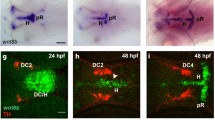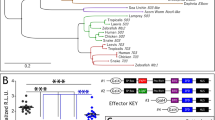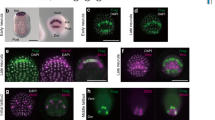Abstract
Organizing centers emit signaling molecules that specify different neuronal cell types at precise positions along the anterior–posterior (A–P) and dorsal–ventral (D–V) axes of neural tube during development. Here we report that reduction in Otx proteins near the alar–basal plate boundary (ABB) of murine midbrain resulted in a dorsal shift of Shh expression, and reduction in Otx proteins at the midbrain–hindbrain boundary (MHB) resulted in an anterior expansion of the Fgf8 domain. Our data thus indicate that an Otx dose-dependent repressive effect coordinates proper positioning of Shh and Fgf8 expression. Furthermore, this control is effective for conferring proper cell identity in the floor-plate region of midbrain and does not require an Otx2-specific property. We propose that this mechanism may provide both A–P and D–V positional information to neuronal precursors located within the midbrain.
This is a preview of subscription content, access via your institution
Access options
Subscribe to this journal
Receive 12 print issues and online access
$209.00 per year
only $17.42 per issue
Buy this article
- Purchase on Springer Link
- Instant access to full article PDF
Prices may be subject to local taxes which are calculated during checkout







Similar content being viewed by others
References
Stern, C. Initial patterning of the central nervous system: how many organizers? Nat. Rev. Neurosci. 2, 92–98 (2001).
Jessell, T. Neuronal specification in the spinal cord. Inductive signals and transcriptional codes. Nat. Rev. Genet. 1, 20–29 (2000).
Rubenstein, J.L.R., Shimamura, K., Martinez, S. & Puelles, L. Regionalization of the prosencephalic neural plate. Annu. Rev. Neurosci. 21, 445–477 (1998).
Lumsden, A. & Krumlauf, R. Patterning the vertebrate neuraxis. Science 2741, 1109–1114 (1996).
Wolpert, L. Positional information and the spatial pattern of cellular differentiation. J. Theor. Biol. 25, 1–47 (1969).
Wurst, W. & Bally-Cuif, L. Neural plate patterning: upstream and downstream of the isthmic organizer. Nat. Rev. Neurosci. 2, 99–108 (2001).
Briscoe, J. & Ericson, J. Specification of neuronal fates in the ventral neural tube. Curr. Opin. Neurobiol. 11, 43–49 (2001).
Houart, C., Westerfield, M. & Wilson, S.W. A small population of anterior cells patterns the forebrain during zebrafish gastrulation. Nature 391, 788–792 (1998).
Litingtung, Y. & Chiang, C. Control of Shh activity and signaling in the neural tube. Dev. Dyn. 219, 143–154 (2000).
Crossley, P.H., Martinez, S. & Martin, G.R. Midbrain development induced by FGF8 in the chick embryo. Nature 380, 66–68 (1996).
Shimamura, K. & Rubenstein, J.L. Inductive interactions direct early regionalization of the mouse forebrain. Development 124, 2709–2718 (1997).
Ye, W., Shimamura, K., Rubinstein, J.L.R., Hynes, M.A. & Rosenthal, A. FGF and Shh signals control dopaminergic and serotonergic cell fate in the anterior neural plate. Cell 93, 755–766 (1998).
Acampora, D., Gulisano, M., Broccoli, V. & Simeone, A. Otx genes in brain morphogenesis. Prog. Neurobiol. 64, 69–95 (2001).
Simeone, A., Puelles, E. & Acampora, D. The Otx family. Curr. Opin. Genet. Dev. 12, 409–415 (2002).
Soriano, P. Generalized lacZ expression with the ROSA26 Cre reporter strain. Nat. Genet. 21, 70–71 (1999).
Lee, K. & Jessell, T.M. The specification of dorsal cell fates in the vertebrate central nervous system. Annu. Rev. Neurosci. 22, 261–294 (1999).
Zetterstrom, R.H. et al. Dopamine neuron agenesis in Nurr1-deficient mice. Science 276, 248–250 (1997).
Smidt, M.P. et al. A homeodomain gene Ptx3 has highly restricted brain expression in mesencephalic dopaminergic neurons. Proc. Natl. Acad. Sci. USA 94, 13305–13310 (1997).
Rowitch, D.H. et al. Sonic hedgehog regulates proliferation and inhibits differentiation of CNS precursor cells. J. Neurosci. 19, 8954–8965 (1999).
Agarwala, S. & Ragsdale, C.W. A role for midbrain arcs in nucleogenesis. Development 129, 5779–5788 (2002).
Acampora, D., Avantaggiato, V., Tuorto, F. & Simeone, A. Genetic control of brain morphogenesis through Otx gene dosage requirement. Development 124, 3639–3650 (1997).
Acampora, D. et al. Visceral endoderm-restricted translation of Otx1 mediates recovery of Otx2 requirements for specification of anterior neural plate and normal gastrulation. Development 125, 5091–5104 (1998).
Millet, S. et al. A role for Gbx2 in repression of Otx2 and positioning the mid/hindbrain organizer. Nature 401, 161–164 (1999).
Broccoli, V., Boncinelli, E. & Wurst, W. The caudal limit of Otx2 expression positions the isthmic organizer. Nature 401, 164–168 (1999).
Ye, W. et al. Distinct regulators control the expression of the mid-hindbrain organizer signal FGF8. Nat. Neurosci. 4, 1175–1181 (2001).
Ang, S.L. & Rossant, J. HNF-3 beta is essential for node and notochord formation in mouse development. Cell 78, 561–574 (1994).
Sasaki, H. & Hogan, B.L. Differential expression of multiple fork head related genes during gastrulation and axial pattern formation in the mouse embryo. Development 118, 47–59 (1993).
Sasaki, H. & Hogan, B.L. HNF-3 beta as a regulator of floor plate development. Cell 76, 103–115 (1994).
Ruiz i Altaba, A., Jessell, T.M. & Roelink, H. Restrictions to floor plate induction by hedgehog and winged-helix genes in the neural tube of frog embryos. Mol. Cell. Neurosci. 6, 106–121 (1995).
Echelard, Y. et al. Sonic hedgehog, a member of a family of putative signaling molecules, is implicated in the regulation of CNS polarity. Cell 75, 1417–1430 (1993).
Epstein, D.J., McMahon, A.P. & Joyner, A.L. Regionalisation of Sonic hedgehog transcription along the anteroposterior axis of the mouse central nervous system is regulated by Hnf3-dependent and -independent mechanism. Development 126, 281–292 (1999).
Watanabe, K. & Nakamura, H. Control of chick tectum territory along dorsoventral axis by Sonic hedgehog. Development 127, 1131–1140 (2000).
Fisher, A.L. & Caudy, M. Groucho proteins: transcriptional corepressors for specific subsets of DNA-binding transcription factors in vertebrates and invertebrates. Genes Dev. 12, 1931–1940 (1998).
Sugiyama, S., Funahashi, J. & Nakamura, H. Antagonizing activity of chick Grg4 against tectum-organizing activity. Dev. Biol. 221, 168–180 (2000).
Simeone, A. Positioning the isthmic organizer where Otx2 and Gbx2 meet. Trends Genet. 16, 237–240 (2000).
Martinez-Barbera, J.P. et al. Regionalisation of anterior neuroectoderm and its competence in responding to forebrain and midbrain inducing activities depend on mutual antagonism between OTX2 and GBX2. Development 128, 4789–4800 (2001).
Li, Y.H. & Joyner, A.L. Otx2 and Gbx2 are required for refinement and not induction of mid-hindbrain gene expression. Development 128, 4979–4991 (2001).
Hynes, M. et al. Control of cell pattern in the neural tube by the zinc finger transcription factor and oncogene Gli-1. Neuron 19, 15–26 (1997).
Ruiz i Altaba, A. Combinatorial Gli gene function in floor plate and neuronal inductions by Sonic hedgehog. Development 125, 2203–2212 (1998).
Litingtung, Y. & Chiang, C. Specification of ventral neuron types is mediated by an antagonistic interaction between Shh and Gli3. Nat. Neurosci. 3, 979–985 (2000).
Agarwala, S., Sanders, T.A. & Ragsdale, C.W. Sonic hedgehog control of size and shape in midbrain pattern formation. Science 291, 2147–2150 (2001).
Acampora, D. et al. Epilepsy and brain abnormalities in mice lacking Otx1 gene. Nat. Genet. 14, 218–222 (1996).
Simeone, A. Detection of mRNA in tissue sections with radiolabeled riboprobes. in In situ Hybridization: a Practical Approach 2nd edn. (ed. Wilkinson, D.G.) 69–86 (Oxford Univ. Press, Oxford, UK, 1999).
Acampora, D. et al. Differential transcriptional control as the major molecular event in generating Otx1−/− and Otx2−/− divergent phenotypes. Development 126, 1417–1426 (1999).
Acampora, D. et al. Progressive impairment of developing neuroendocrine cell lineages in the hypothalamus of mice lacking the Orthopedia gene. Genes Dev. 13, 2787–2800 (1999).
Acknowledgements
We thank A. Lumsden, A. Pierani, L. Puelles and C. Stern for comments on the manuscript. We are grateful to J. Rubenstein for the Nkx6-1 probe, A. Pierani for Msx1 and Dbx1 probes, G. Cossu for the R26R mouse strain, S. Guthrie for αISL1 and A. Secondulfo and S. Boscolo for manuscript preparation. We are also indebted to L. Cashnella and J. Marven for excellent animal care. This work was supported by the Medical Research Council (N. G9900955), the Wellcome Trust (N. 062642/Z/00), the EU BIOTECH Program (N.QLG3-CT-2000-02310), the FIRB Neuroscienze PNR 2001–2003 (FIRB art.8) D.M. 199, the MURST-CNR Program “legge 488/92” (cluster 02) and the Fondation Bettencourt-Schueller to A.S. This work was also supported by the EU BIOTECH Programme, the Association pour la Recherche sur le Cancer, the Institute National de la Santé et de la Recherche Médicale, the Centre National de la Recherche Scientifique and the Hôpital Universitaire de Strasbourg to S.L.A., and by the Bundesministerium für Bildung und Forschung (BMBF) to W.W. E.L. was supported by a pre-doctoral fellowship from the Ministère de la Recherche, and S.F. was supported by an EMBO fellowship.
Author information
Authors and Affiliations
Corresponding authors
Ethics declarations
Competing interests
The authors declare no competing financial interests.
Rights and permissions
About this article
Cite this article
Puelles, E., Acampora, D., Lacroix, E. et al. Otx dose-dependent integrated control of antero-posterior and dorso-ventral patterning of midbrain. Nat Neurosci 6, 453–460 (2003). https://doi.org/10.1038/nn1037
Received:
Accepted:
Published:
Issue Date:
DOI: https://doi.org/10.1038/nn1037
This article is cited by
-
The embryonic patterning gene Dbx1 governs the survival of the auditory midbrain via Tcf7l2-Ap2δ transcriptional cascade
Cell Death & Differentiation (2023)
-
OTX1 exerts an oncogenic role and is negatively regulated by miR129-5p in laryngeal squamous cell carcinoma
BMC Cancer (2020)
-
Molecular heterogeneity and CXorf67 alterations in posterior fossa group A (PFA) ependymomas
Acta Neuropathologica (2018)
-
Lacking of palladin leads to multiple cellular events changes which contribute to NTD
Neural Development (2017)
-
Embryonic development of selectively vulnerable neurons in Parkinson’s disease
npj Parkinson's Disease (2017)



